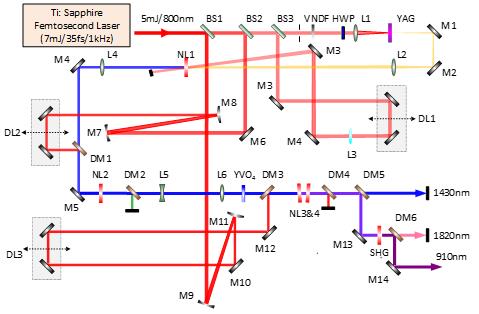100 PW level laser facilities, such as the Station of Extreme Light facility (SEL) under construction in China, can advance research in attosecond science and strong-field physics. These systems require a high-performance laser seed at 910 nm since the DKDP crystals provide the broadest gain bandwidth when pumped at 527 nm. Furthermore, a clean pulse is demanded to suppress destructive pre-plasma generation. Therefore, it is significant to produce a broad-bandwidth high-contrast laser seed centered at 910 nm.
One recent study by a research team from Shanghai Institute of Optics and Fine Mechanics, Chinese Academy of Sciences (CAS), demonstrated a broad-bandwidth high-temporal-contrast carrier-envelop-phase-stabilized laser seed for 100 PW laser facility, which was based on white-continuum generation (WLG), cascaded optical parameter amplifier (OPA) and second harmonic generation (SHG). The result was published in Optics Letter.
In the experiment, researchers generated an over-200-nm bandwidth pulse at a 1 kHz repetition and a centered wavelength of 910 nm. This high-quality laser seed was from a second harmonic generation of a super broadband idler beam of OPAs.
In the OPA process, researchers employed a dual-crystal design to amplify the signal beam, which could provide a combined gain bandwidth broader than single crystal, and then they obtained the broadband idler as input to SHG process.
In order to generate ultrashort pulses, researchers considered carefully the group velocity dispersion (GVD) mismatch condition. Through precise control of different material thickness, they compensated the overall dispersion and ultimately obtained 14.8 fs duration pulses.
In addition, the experiment showed that it was exactly the OPA and SHG processes that enhanced the pulse contrast by 4 orders of magnitude in time domain. The obtained contrast output could reach 1012 that is highly-demanded in 100 PW laser facilities.
Compared with other technologies such as hollow core fiber (HCF), this configuration also provided a stable energy with 0.8% rms in 30 min.
As is known to all, 100 PW laser systems will provide powerful tools for studying ultra-relativistic phenomena, including vacuum QED, proton acceleration, and laboratory astrophysics. The laser output source at 910 nm can be used as the laser seed for DKDP-based OPCPA systems, and will be integrated into the SEL-100 PW system in the near future.

Schematic of the laser seed system. (Image by SIOM)
Article website: https://doi.org/10.1364/OL.390110
Contact:
Mr. CAO Yong
General Administrative Office
Shanghai Institute of Optics and Fine Mechanics, CAS
Email: caoyong@siom.ac.cn